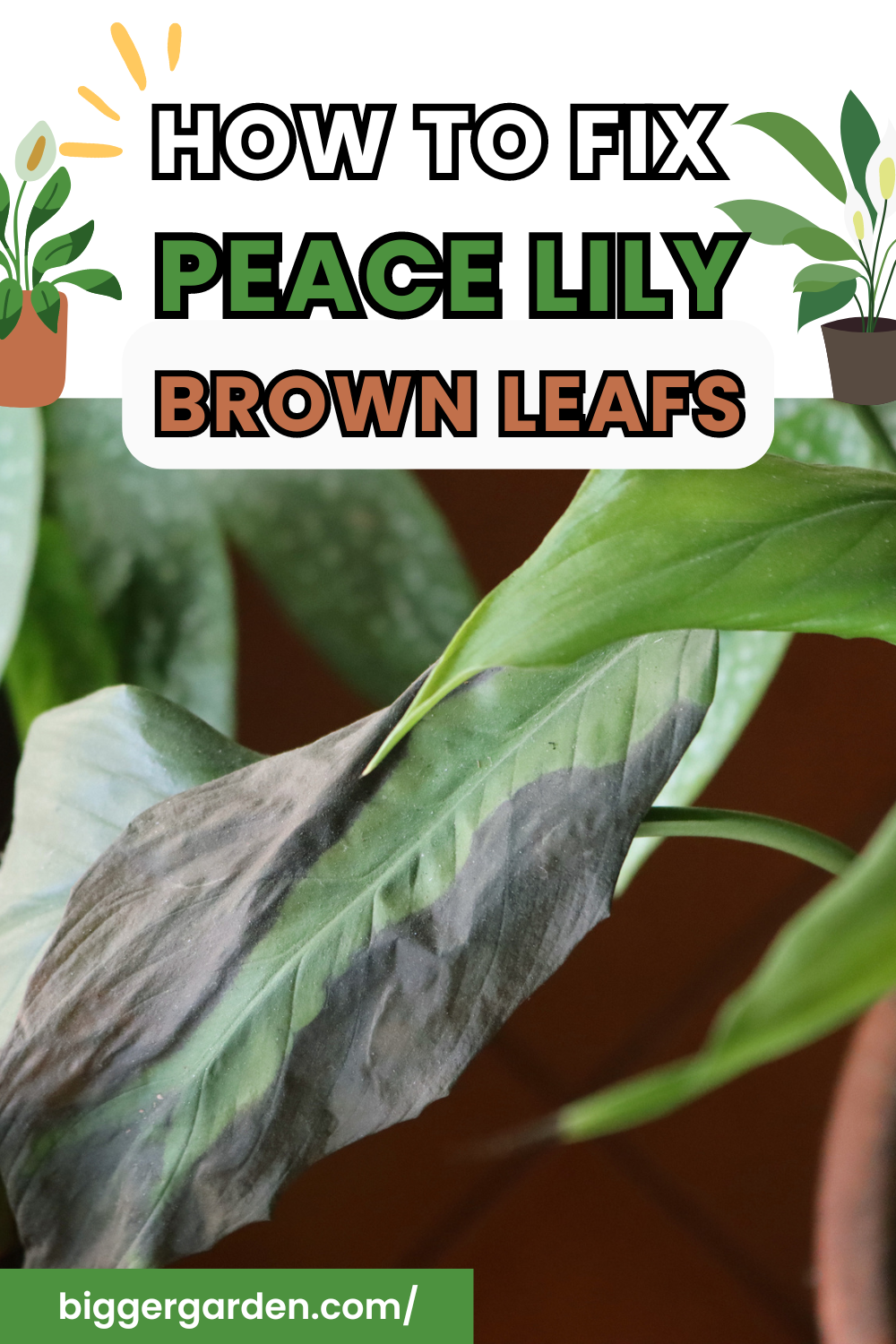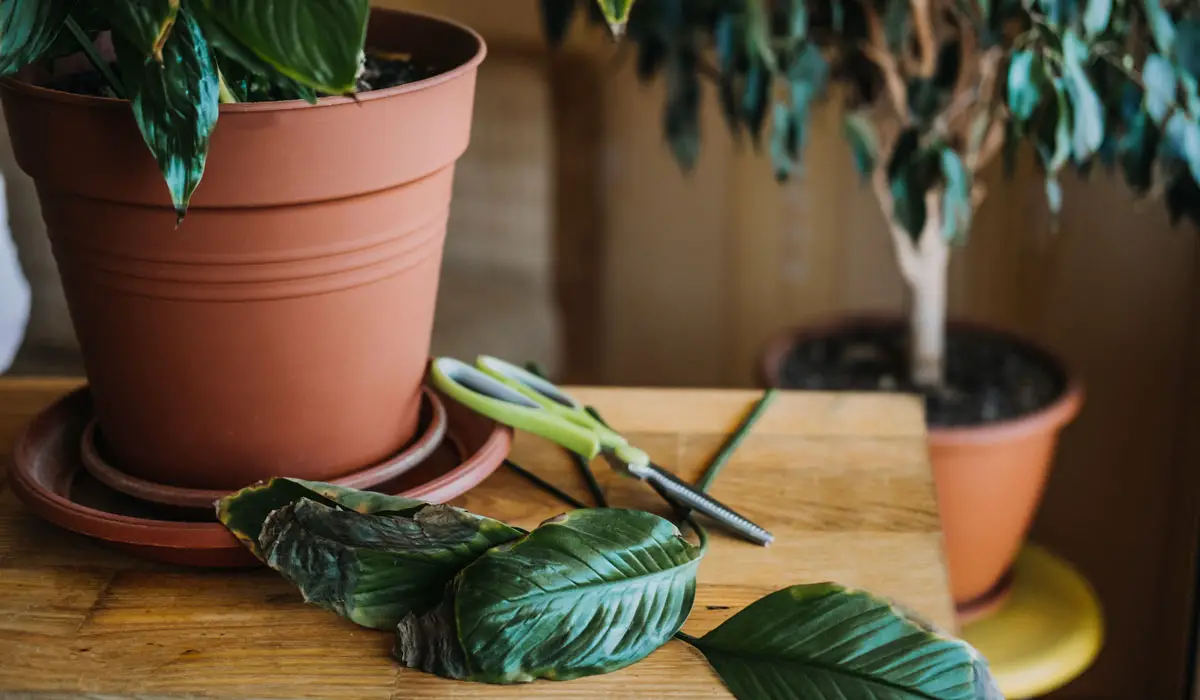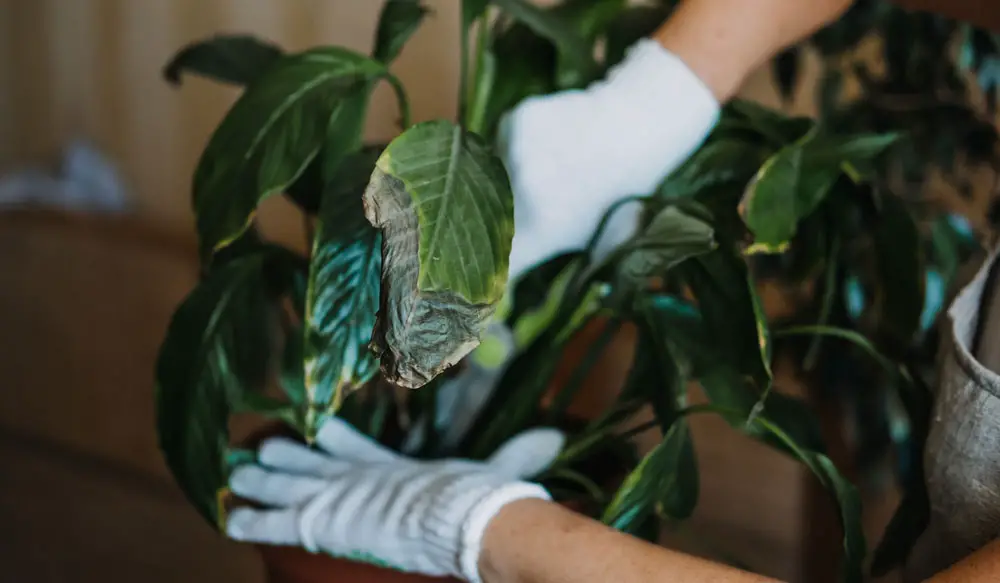5 Reasons Peace Lily Leaves Turn Brown: How to Identify and fix

This post follows our research editorial guidelines.

Brown leaves on your peace lily (Spathiphyllum) can feel like a punch in the gut. You’ve spent hours caring for this lush white flower just to realize the leaves are beginning to turn brown, showing signs of stress.

Getting them back to good shape is easier than it seems, thankfully. There are a few different causes, but once you get a grip on their care needs problems like brown leaves become a distant memory. Let’s take a look through what I’ve learned over the years on how to keep those luxurious leaves a luscious, luminous green.
Table of Contents
Why do Peace Lilies leaves turn brown?
Inappropriate watering or too much direct sunlight are the most common causes of brown leaves on peace lilies. Temperature shock, fertilizer problems, or poor humidity also contribute. While brown leaves can’t be revived, corrections to the lily’s care will prevent them from happening in the future.
What Causes Peace Lily Leaves to Turn Brown?
Water Drama
Peace lilies are a bit precious about their water. They need consistently moist soil that nonetheless doesn’t become boggy or wet for extended periods of time. It also has to be just the right temperature, and just the right type of water too, believe it or not. Get it wrong in either direction, and you’re going to have drama.
Over-watering
I’d say nine times out of ten, if there’s brown leaves on a peace lily the culprit is over-watering. When we over-water, the soil loses tiny pockets of air the lily needs to breathe. They start to drown, and can no longer transport water to the leaves. Despite the abundance below the soil the leaves above start to dehydrate and die.
Under-watering
An under-watered peace lily will usually let you know it’s thirsty by drooping dramatically long before damage occurs. But if you’ve been repeatedly tardy with the watering can, the accumulated damage will show in brown tips and edges, especially around the central supports of each individual leaf.

Poor Quality Water
Peace lilies are very chemically sensitive, and they demand only the best of the best when it comes to water. They don’t like hard water, softened water, tap water that has chlorine or fluoride added, or water that’s too cold or hot. Exhausting, isn’t it?
“Peace lilies, or Spathiphyllum, are popular houseplants because they are generally easy to grow, have pretty flowers and can tolerate lower light levels. But lots of people do have problems with them.”
David Graper, Professor Emeritus of Horticulture Science at South Dakota State University
How To Correctly Water a Peace Lily
Peace lilies need to be kept moist without becoming soaked. They also tend towards densely packed roots, so it can be a bit of work to get that water in there! To achieve this, I generally recommend a mix of watering from above and below only when the top inch or so of soil is completely dry.
Watering from above is exactly as it sounds – just pouring clean water into the top of the pot itself. The trick here is quantity – you must really drench a lily when watering from above, until water flows from your drainage holes. This gets water right down to the bottom, and the flow through removes chemical buildup as a bonus.
Watering from below involves placing your plant in a large tub of clean water, so that it soaks into the drainage holes and re-hydrates from the root up.
The best water for peace lilies is rain water. Distilled or filtered water is also safe. Avoid spring water, as it often has a lot of dissolved mineral salts that can build up in the soil and cause the same sort of damage, you’re trying to avoid in the first place!
Personally, I use a cartridge style filter jug to purify water for my plants -I treat it like an extra fancy watering can. It’s cheaper than buying distilled water in a bottle and takes up less space than collected rainwater, too.
Try to use room temperature water if you can. Colder water won’t kill them, but a sudden drop in temperature to the roots can cause damage over time. You also need to make sure any saucers or drip trays are kept empty, as they’ll rot from the root up if you let them sit in standing water.

Sun Damage
Peace lilies love moderate to bright indirect light. They evolved to grow on the humid forest floors of Central America and South East Asia, so dark, glossy leaves are optimized to soak up every stray bit of luminescence. They’re very sensitive to the light of the sun.
Sun damage looks like the leaf has been tossed into a microwave or oven – it’ll crisp up from the tip inwards, shriveling and losing its color. They may also show pale bleached patches that turn a dry, papery brown, sometimes flaking away entirely.
How To Fix Sun Damaged Peace Lilies
There’s not much to be done for the sun damaged leaf. It’s fried, and your best option is to remove it.
Next, move your peace lily to a location out of the sun. A room with a good sized southern facing window is perfect. Keep an eye on the light as the seasons change – I’ve been caught out more than once by a winter sunbeam that shifts right onto my plant as the summer approaches.
Temperature Shock
Like direct sunlight, a sudden heatwave will cause the peace lily to suffer. When the mercury shoots up suddenly it’s tough for person and peace lily alike! Heatwaves will dehydrate the plant quickly, resulting in a wilting lily that otherwise has enough water in its soils.
A cold snap results in even more damage. Peace lilies are especially vulnerable to chills, showing severe damage well above freezing temperatures. The leaves wilt and turn black from the tips and margins inwards, rotting away. Older foliage is most at risk, but the younger leaves that survive a chill slow down their growth, resulting in foliage that’s smaller and frailer.
How To Fix Temperature Shock in Peace Lilies.
Remove any badly damaged leaves, as they’ll rot on the plant and cause infections. In future, ensure your growing environment is kept consistently warm. Peace lilies do best if they’re kept at around 68 and 85°F(20 to 30°C). They’ll tolerate overnight dips in temperature, but anything below 60°F (15°C) will cause die back.

Inappropriate Fertilization
As mentioned above, peace lilies are very chemically sensitive. This extends to fertilizer, which presents us with something of problem. How to fertilize a peace lily when they’re as likely to be hurt as be helped by it?
Too much fertilizer results in chemical burns not dissimilar to those that develop due to chlorine or fluoride in tap water. The roots are scalded and the leaves crisp up from the tips inwards.
How To Fertilize a Peace Lily
Peace lilies don’t need much fertilizer at all when grown indoors. Generally they only need it during the spring, so a half strength dose of balanced liquid fertilizer given once every other month during spring and summer is ideal.
If you’ve overdosed your poor lily, you can correct the damage by flushing the pot. All this involves is running an abundance of clean, room temperature water through the pot, allowing excess fertilizer to dissolve and be carried away.
I’ve found it best to give mine a lukewarm shower once a year in the spring. It’s a bit of a spa day, as using a shower-head to administer water from above is a great chance to wash the winter dust from the lily’s leaves too. The whole plant gets freshened up, roots and all.
Low Humidity
Most homes and offices rarely reach the humidity levels beloved by these tropical treats, and peace lilies will express their displeasure with brown, crisp leaf tips. This is especially true if you have strong climate control, as HVAC systems thoroughly remove moisture from the air.
How To Fix Low Humidity for a Peace Lily
The most direct way of fixing low humidity around a peace lily is to invest in a humidifier. Placed near the peace lily, it’ll get that moisture level in the air back up to levels the plant will love.
Other options include clustering plants together to create a tiny micro-jungle, where moisture lost from leaves or soil increases the local humidity for all the plants there to enjoy. You can also move the peace lily grows to a humid part of your home, like a bathroom.
Should you cut brown leaves off peace lily?
There’s not much to be done for an entirely brown leaf. There’s no coming back from that, so just chop them off.. Those dead leaves will start to rot, and if they’re in contact with healthy tissue the rot’s likely to spread.
That said, leaves that are only a little bit brown, especially at the tip, can generally be ignored. My rule of thumb is that if the leaf is at least two-thirds green it can be left in place. Green leaves produce the fuel your peace lily needs to grow new, fresh foliage.
How do I know if my Peace Lily is over-watered?
Brown leaves that are limp, soft or turning black are key signs of an over-watered plant. They’ll often start yellow at the tip, blotchy or patchy, and spread down the leaf.
Other signs of over-watering include:
- foul smelling soils
- pot that is heavy and that constantly seeps water from the drainage holes
- consistently wet, boggy soil
- mold or mildew on the soil surface
- heavy infestations of fungus gnats
Final thoughts
Peace lilies are a fantastic indoor plant for new plant enthusiasts just branching into more challenging choices. Their elegant flowers and rich green foliage elevate any room they grace. When their preferences are met, they are a long-lived elegant addition to any home or office.
